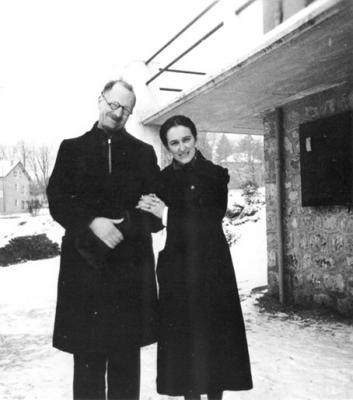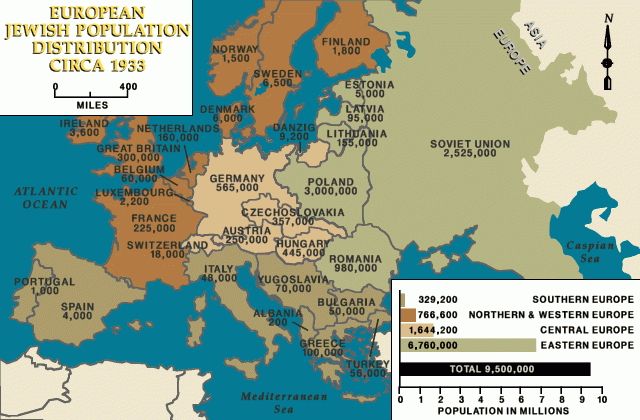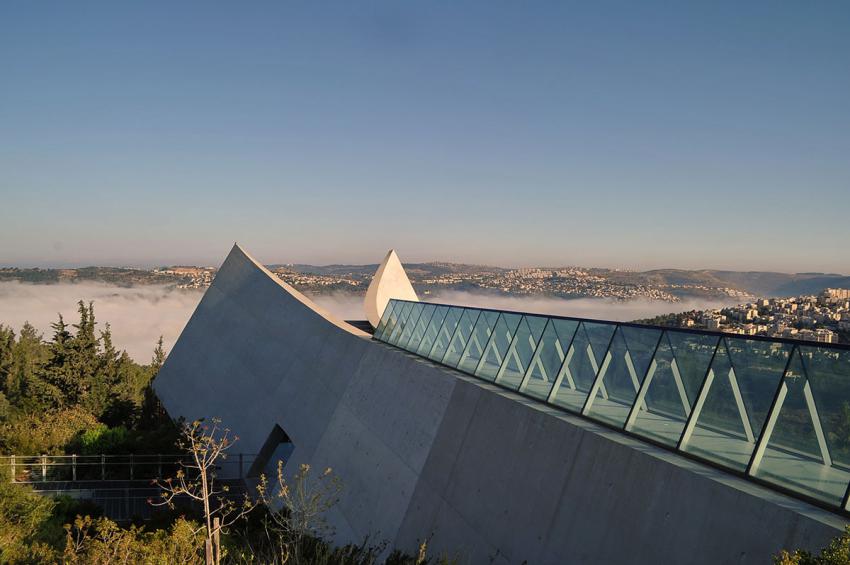 |
| Andre and Magme Trocme |
We visited YAD VASHEM, Israel's official memorial to the victims of the Holocaust. The Hebrew name means " a memorial and a name." In the aftermath of the Holocaust, survivors were left with nowhere to grieve their lost relatives or preserve the memory of the dead. The museum is dedicated "to preserving the memory of the dead; honoring Jews who fought against their Nazi oppressors and Gentiles who selflessly aided Jews in need; and researching the phenomenon of the Holocaust in particular and genocide in general, with the aim of avoiding such events in the future." Spending time there was formative and powerful.
Here is a link which shows the number by country of those who would lose their lives during the war https://encyclopedia.ushmm.org/content/en/article/jewish-losses-during-the-holocaust-by-country
Shoshanna, a grateful mother of 6, who had immigrated to Israel (or made Aliyah) 5 years prior, was our guide through the experience. We first stood together before one of the 2,200 trees that had been planted in honor of those named Righteous Among the Nations, having given their lives in an attempt to save Jewish people. Ours was a carob tree with an engraved plaque at its base, bearing the names of Andre and Magde Trocme from the village of Le Champon in southeastern France. Andre was a Protestant minister who was determined to make his town a city of refuge. He and his wife convinced their congregation and the town residents to be part of a smuggling operation to aid those fleeing from Nazis. Through their efforts, nearly 5,000 lives were saved. Andre was quoted as saying, "These people came here for help and for shelter. I am their shepherd. A shepherd does not forsake his flock... I do not know what a Jew is. I know only human beings." The carob tree was also symbolically chosen as carob beans weigh the same amount, so much so that they were used as weights and measures for jewels - which is the origin of the term carats. These people valued each and every life as precious and sacred, as we all should. The first trees were planted in the 60's, and as more and more stories have come out over time (especially in the 90's as Holocaust survivors neared their death and felt they must tell their stories for future generations) more people were named Righteous among the nations, so much so that they ran out of space for trees, so they also created a memorial wall bearing their names and honoring their sacrifice. As of now, 22,000 have been named as Righteous Among the Nations. Their stories can be found athttps://www.yadvashem.org/righteous.html
The museum began with a snapshot into Jewish lives and communities before World War 2, in the 1920's and 30's. Many of the Jewish people spoke Yiddish, a blend of medieval Hebrew and German. The synagogue was a place of worship and also the center of village life. The Jewish people were joyful, productive and engaged members of society and contributors to the arts, sciences and commerce in the many countries in which they took up residence. While anti-semitisim and oppression of the Jews was unfortunately far from a new occurrence, all previous persecution would be far surpassed by the evil the Nazi's had in store. One thing that struck me from the presentation, was how many different countries had large Jewish populations which were impacted by the Nazi regime. Previously, I had thought of the Jews of France, Germany, Poland, and Russia being primarily affected. Untold Jewish lives from Belgium, Bulgaria, Czechoslovakia, Slovakia, Greece, Hungary, Italy, Latvia, Lithuania, Luxembourg, Netherlands, Norway, Romania, Yugoslavia, Slovenia, Serbia, Macedonia, Croatia, and more, would be lost. The Jewish people had found a distinct way of life in each of these lands, and stood to lose everything. Here is a map from the Holocaust Encyclopedia, showing the Jewish population throughout Europe before the Second World War.

There were 9.5 million Jews in Europe before the war and the death camps. During the Holocaust, 6 million Jews were slaughtered, 1.5 million of those were children. I wonder how many Jews there would be in the world today, had there been no Holocaust. One survivor went on to have 50 grandchildren. A quote Shoshanna shared which struck me was: "He who saved one life, it's as if he saved a whole world." And conversely, "He who murders one life, it's as if he murdered a whole world."
After giving us a glimpse of life in Jewish communities throughout Europe, we began the chilling descent into the Nazi's regime to systematically exterminate a whole people group. It began by propaganda and labeling, and we saw several examples of propaganda in which Jews were depicted as parasites, or greedy, corrupt and bulbous-nosed thieves who were only out to exploit, and couldn't be trusted. All Jews had to wear clothing marked with yellow stars, visible from the front and the back.
After the labeling (which is frighteningly similar to what can happen to people groups today through biased media), came the despoiling and depossession. Property and valuables were seized from Jewish households without explanation or legal recourse. Unfortunately, the greed of resentful neighbors played into the Nazis evil plans, and many community members refused to shelter their Jewish neighbors for a share in the spoils.
Next came the expulsion to ghettos, and there were over 1,000 ghettos in Europe, at the time when the first concentration camp was only in Germany. We learned specifically about the Warsaw Ghetto where 350,000 Jews were put inside, a wall was built around, and another 250,000 were shipped in to join them. A living situation which might be suited for 50,000, now held 500,000. Films were made by the Nazis of filthy and crying children in the streets and suffering and diseased people in loathsome conditions to try to prove the baseness of the Jewish race. Rather than contempt, the films evoked compassion, so the Nazis changed tactics and went on to carefully produce a film in which all ghetto residents were well-fed, had organized games, and were growing abundant food at a time when most were hungry in Europe. Those involved in the making of this film project were fed, cleaned and clothed well for the first time, just for this filming, but killed after the production, to eliminate witnesses. The Nazis were careful to keep up the image to the Red Cross, that the conditions within the ghetto were optimal, that one Jewish settlement camp could even be considered a "spa towns" that had been gifted to the Jews by the Fuhrer. Residents found ways to smuggle out photos, journals and sketches of what really went on. Those caught doing this were executed. In the harsh winters of 1940 and 41, nearly all of the bottom steps were missing, because they were needed for firewood. Dwellings were overcrowded, sanitary systems insufficient, disease rampant, little protection from the elements and food was scarce. 100,000 Jews died in the Warsaw ghetto in 2 years.
Unbelievably, the Nazis had more horror in store. Round-ups and deportations were well underway by this time. I was shocked to hear that there were over 20,000 different concentration camp, the largest with a capacity for 10,000, and others holding from 500-2,000 people.
Upon arrival at the camps all were divided into useful and useless. Husbands were separated from wives. Children were separated from mothers. Brothers and sisters were separated. Even so, hope was used as a weapon as they passed under signs with happy sayings. Had they known what was fully in store for them, revolt would have been inevitable. Upon arrival, each inmate was dehumanized, as they were stripped, their heads and bodies shaved (for"one louse equals death" as louse spread typhus), numbers tattoed on their arms, and bodies reclothed in prisoner's stripes. We heard of two sisters who were sent through this shaming process, and afterwards were screaming and unable to find one another. A little while later, they were shocked to finally see that they were side by side, and had been too traumatized and changed to recognize one another. At the concentration camps, like Dachou, those deemed unuseful or those being punished, were certainly exterminated, but not to the same degree as the death camps.
Systematic and total murder was well underway at this point. The land was to be "cleansed" of the poison that was the Jews", starting with only men. Six of the 20,0000 concentration camps were death camps, built with the express purpose of killing the Jews of Europe. Treblinka was the deadliest of the death camps, killing 870,000 Jews in 13 months, while Auschwitz was the largest, killing 1.1 million over a longer period. Zonder commandos were Jewish slaves forced to work in the death camp, and tasked with cutting off gold stars from the piles of belongings deemed valuable enough to give as gifts. They also had the horrific tasks of removing golden teeth from victims before either burning or burying them.
Once it was evident that the war was lost, German armies killed all prisoners, burned all the evidence they could, before fleeing, in order to leave no living witnesses. One camp in Poland was destroyed, covered and dirt and had trees planted quickly on top. One group of Russian soldiers came upon a pile of recently killed prisoners from the retreating German army, and painstakingly went through the bodies of the fallen, looking for personal affects, and ways to identify them for their families. Worn photos, treasured letters, and a few personal effects which hadn't been confiscated were found, and kept, and some were displayed there at the museum.
After the war, people described it as the Agony of Liberation. Many had no homes to return to. Or family members to comfort. Finding loved ones, or the remains of loved ones seemed an impossible task. There were camps for displaced people. They had lost their cultural identity and their way of life, their synagogues, local rabbis, and ways of worship and doing life. Many dealt with survivor's guilt, wondering why they had made it through these horrors, while others had not. Many wanted to leave Europe, and seek healing in Israel, but that too was a closed door in 1945, as there was a limit of 15,000 Jewish immigrants per year.
I was struck by the insidiousness with which a group of people can be marginalized, then ostracized, then terrorized, and even systematically murdered, without the vehement protection or moral outrage of decent people. It's as if the moral outrage of people was lulled to sleep over time, or justified out of a desire for self-preservation or the protection of national identity. It made we want to pray that I never allow myself to undervalue another life or culture, especially the marginalized. I was also saddened to see ways in which the historical Christian church has played a role in Anti-Semitism throughout the ages (brutally forced conversions in the Crusades, justifying cruelty against "Christ killers", and tolerating doctrine which refuses to acknowledge the place for Israel in the Kingdom). While gratefully, there were plenty of Christians who did take a stand at great personal cost, there were others which did not. May we never give silent assent to the intolerable or stand by and do nothing when something demands to be done. God help us to learn here, what must be learned, and may we "never allow such destruction to happen again."
As an aside, I kept wondering how these lessons should apply to the immigrants and refugees entering America, and what my response should be as they seek to find a life in my community (Honestly, I find myself particularly opposed to Muslims). Certainly, this cannot be directly compared to the Holocaust, and politicians have complex policy decisions to make, but I do see in myself ways that self-preservation, national identity, personal comfort and fear can provide fierce temptation to have nothing to do with an entire people group. Or to see people as an interruption to my way of life, or a threat to my freedom and comfort, rather than souls which our God longs to reveal Himself to.
Yad Vashem found a beautiful way to collect the names and stories of 4.8 million lives, and memorialize them, and continues the process of seeking out Shoah victims that they be remembered. For not to forget is passive, but to remember is to be proactive.

Leaving the museum, we were led to a beautiful overlook of the hillside and swaying trees, as the designer wished that we be "bombarded by life."

Following our visit to Yad Vashem, we also visited the Friends of Zion museum, and were blessed to hear testimonies of people throughout the ages, who have been a blessing to Israel.
My favorite account was of the grandparents of Corrie Ten Boon, one of my heroes and the author of "The Hiding Place." Her grandparents had hosted years of prayer meetings for the people of Israel, long before the start of World War 2, in which their son and grand daughters would be used to save Jewish lives, and would suffer for Christ in the concentration camps and go on to be a testimony of the reconciliation and forgiveness only available through Christ the Messiah.
1 comment:
What a clear, thorough description Julia! I learned so much from this and would like to share it with others if you are okay with that. Love and prayers - Debbie
Post a Comment